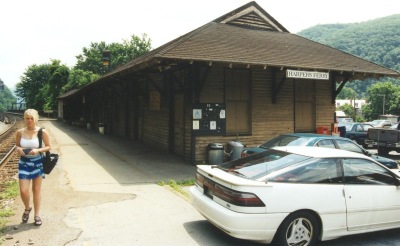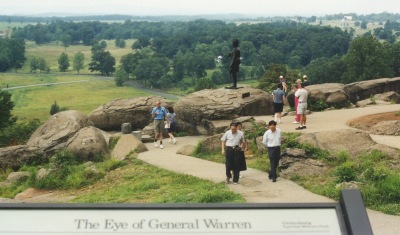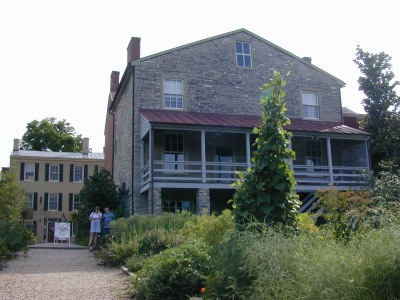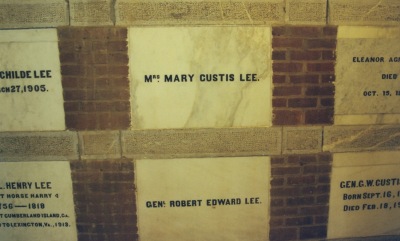Take two battlefields, add a couple of presidents and a few generals
Next day the sick part of the family had
finally gotten over their various troubled stomachs, and as the family's youngest, Britt,
was bitten by a dolphin bug and her only dream at that time was to become a
dolphin trainer, they drove from DC to Baltimore in Maryland, to
visit the dolphinarium. The rest of the company would rather see the small town of Harpers Ferry in
West Virginia, where Dorte and Carl two years earlier had eaten cinnamon rolls! Today's final goal was Gettysburg, Pennsylvania, so we
all agreed to go our separate ways and just meet there in the afternoon.
 We drove north out of Washington
and along minor roads through Maryland. In the small town of White's Ferry we crossed the river on
a small cable ferry - one of the few ferries that still carries passengers
across the Potomac.
Well across
the
river, we continued to Harpers Ferry.
The whole city and its surroundings are part of Harpers
Ferry National Historic Park. The small town of Harpers Ferry or "Shenandoah
Falls at Mr. Harper’s Ferry" a it was originally called is situated where
the rivers Shenandoah and Potomac meet, and was founded when Robert Harper established
a ferry service here in the middle of the 1700s. The ferry service
ended around 1800 when bridges were built across the rivers, but the name still
reminds us of the past. The town was the birthplace of american industry, and
later played an important part in the civil war when it shifted hands between north
and south eight times. A few years before the war, abolitionist John Brown and
his men were captured here by soliers from the U.S. Marine Corps commanded by
then Colonel Robert E. Lee.
We drove north out of Washington
and along minor roads through Maryland. In the small town of White's Ferry we crossed the river on
a small cable ferry - one of the few ferries that still carries passengers
across the Potomac.
Well across
the
river, we continued to Harpers Ferry.
The whole city and its surroundings are part of Harpers
Ferry National Historic Park. The small town of Harpers Ferry or "Shenandoah
Falls at Mr. Harper’s Ferry" a it was originally called is situated where
the rivers Shenandoah and Potomac meet, and was founded when Robert Harper established
a ferry service here in the middle of the 1700s. The ferry service
ended around 1800 when bridges were built across the rivers, but the name still
reminds us of the past. The town was the birthplace of american industry, and
later played an important part in the civil war when it shifted hands between north
and south eight times. A few years before the war, abolitionist John Brown and
his men were captured here by soliers from the U.S. Marine Corps commanded by
then Colonel Robert E. Lee.
The picture shows Tina and her interesting hairdo (actually best seen from behind; see the story of our visit to Washington DC), next to the towns railway station.
The old part of the town has only three streets, Shenandoah Street, Potomac Street and High Street. We spent about 2-3 hours in an around the small town, and more importantly, got ourselves one of the famed cinnamon rollls. Dorte and Carl had praised them, and they were indeed ok.
After the visit to Harpers Ferry we continued
to
Gettysburg. We had booked rooms at
the city's oldest hotel, the Hotel Gettysburg, dating from 1797.
The hotel was located in Lincoln Square, the city's
central square. After getting our rooms, we went out to explore the city. Outside the hotel
were various horse carriages, that took tourists around town. Tina are rather
keen on horses, and the guides of such tours use to be good storytellers, so we
bought a tour. We, at that time counted Dorte, Tina and I, as Tim preferred to
stay in the hotel with a book. Along the way, the driver told us many
interesting stories, some true others not so true. Among the true stories, she
told us the story of the many small brass signs, that you find on many of the houses
in town,
and that certifies that the house in question was
already built before the Battle of Gettysburg. Furthermore, we were shown a
cannonball in the wall of a candy store. More interesting was the story of Jennie Wade, the only civilian killed
during the Battle of Gettysburg and the places in town, connected with her.
Further on we passed Culp's Farm, a farm,
which originally was outside town near Culp's Hill, where heavy fighting
took place during the battle. Here we heard the story of Wesley Culp, nephew to the farmer,
that owned the farm during the Civil War. You can read more of Jennie Wade, her
maybe fiancé, Jack Skelly and Wesley Culp on the Internet or
in "The Jennie Wade Story" by Cindy L. Small.
Next day we visited the
Gettysburg National Battlefield Park, with its 1,400 war monuments, battlefields,
etc. We started by going out to the park's Visitor Center. Here we bought a map
of a self-guided tour around the park. Beside the map, there were descriptions
of what happened at a few selected stops (18 total). The tour had two routes, a
two hour version and one that would last three hours. We chose the shorter of
the two, but even so we managed to spend four hours along the way! There have
been written many books
about the battle, so I will not go into any details but it was one of the most
bloody battles of the Civil War with more than 51,000 casualties on both sides.
W e
started the tour by driving to the first stop at Herrs Ridge, where the battle
started on July 1,st 1863. From there
we continued to the next three stops, but by then Tina was fed up with guns and monuments, so we had
to take her back to the hotel where she
could join the rest of the family by the swimming pool. Dorte, Tim and I
returned to the battlefield and continued the tour. We passed or made stops at
places like Little Round Top, Culp's
Hill, The Wheat Field, The Peach Orchard, Devil's Den, Slaughter Pen and Valley of Death. When we got back to the hotel,
our heads suffered from "monument overload", but if you are interested in the Civil War
and are in southern Pennsylvania, Gettysburg is a must.
e
started the tour by driving to the first stop at Herrs Ridge, where the battle
started on July 1,st 1863. From there
we continued to the next three stops, but by then Tina was fed up with guns and monuments, so we had
to take her back to the hotel where she
could join the rest of the family by the swimming pool. Dorte, Tim and I
returned to the battlefield and continued the tour. We passed or made stops at
places like Little Round Top, Culp's
Hill, The Wheat Field, The Peach Orchard, Devil's Den, Slaughter Pen and Valley of Death. When we got back to the hotel,
our heads suffered from "monument overload", but if you are interested in the Civil War
and are in southern Pennsylvania, Gettysburg is a must.
The picture shows the statue of Brigadier General Governeur K. Warren at Little Round Top.
After the tour, it was our turn to jump into the pool to relax and digest all the impressions from that day. In the evening it was time for yet another walk around town, concluded with a nice dinner for all 11 of us together.
This was the two battlefields of the title of the story. I haven't mentioned any
of the several
generals that participated at Gettysburg, because thats not what the header was all about.
So let me get to that part - and the presidents as well.
The vacation was almost over and we had to go southwards
towards Knoxville again. The first
stage would take us from Gettysburg and south to Lexington, Virginia. We left after
eating breakfast at the Lincoln Diner in Gettysburg. There's not much to tell
about the trip south. We took Interstate 81 down through Pennsylvania, Maryland,
West Virginia and into the Shenandoah Valley. On the border between West Virginia
and Virginia, we stopped at a Welcome Center to get maps and brochures.
We had made it a virtue to stop at all Welcome Centers we came across, and equip
ourselves with tourist brochures and maps, but hadn't passed one, going north
into Virginia. Dorte and I were so keen on getting especially maps, but also
brochures, that the kids was starting to think that we
suffered from "brochuritis". And on our next trip our "welcome
center hysteria" rose to new levels. On the way south we just made a few
stops for "biological reasons" and to get something to eat. Dorte had insisted
that she at least once before the vacation were over would eat at a Waffle House, so
when we met one of those at lunchtime, we had to eat there.
We got to Lexington in the afternoon, and quickly found
our hotel. It turned out later that the hotel had an really good restaurant, but
but what most interested the majority of the company at that time, was the part indoor, part
outdoor swimmingpool. Dorte and I delayed our visit to the pool, as we would
rather go into town (we stayed at a hotel, just outside town). According to some of
the brochures, we had gotten at the Welcome Center, it appeared that Lexington could
be a very interesting town. So we drove to the center of town.
 We started
our visit at the local
Visitor Center. This was partly a coincidence, since the place was next to the
parking area, where we left the car. It was around 17 PM, and the place was
about to close,
but when we entered we were received with great enthusiasm by the lady on duty. She asked us where
we came from, and when we told her Denmark, she got quite excited. She told us we
were the first Danes who had ever set foot on the premises.
To prove
this, she brought out a book, in which all foreign visitors were accounted
for. She seemed so happy that we considered going back to the hotel, and sending all the others
down there in groups of two! She told us that the guided walking tours of the
town was over for the day, but she gave us a map and a written copy of the
stories, that the guides normally told during the tour. We thanked her and left
the place again. Our first goal was a bench right outside the Visitor Center, where we studied
the
map and descriptions, and made a battle plan for what was left of the afternoon.
We started
our visit at the local
Visitor Center. This was partly a coincidence, since the place was next to the
parking area, where we left the car. It was around 17 PM, and the place was
about to close,
but when we entered we were received with great enthusiasm by the lady on duty. She asked us where
we came from, and when we told her Denmark, she got quite excited. She told us we
were the first Danes who had ever set foot on the premises.
To prove
this, she brought out a book, in which all foreign visitors were accounted
for. She seemed so happy that we considered going back to the hotel, and sending all the others
down there in groups of two! She told us that the guided walking tours of the
town was over for the day, but she gave us a map and a written copy of the
stories, that the guides normally told during the tour. We thanked her and left
the place again. Our first goal was a bench right outside the Visitor Center, where we studied
the
map and descriptions, and made a battle plan for what was left of the afternoon.
It was at that time, we discovered that the town had a
lot of historical celebrities to offer. Now it is very easy for a celebrity to be connected to a place in the USA. At one of our later trips we visited
Statesville, North Carolina. Here they "boasted" of a "Vance House", a museum of Zebulon Vance. Heard of
him? Maybe not. At least not many Danes have. Actually he was the Civil War governor of North Carolina
and he had stayed one month in the house some time after the war. That was
enough to make it a "Vance House".
The brochures from the Visitor Centre mentioned some celebreties that were more or less connected to the town.
- George Washington, general and president, had donated some money to the towns university i 1796.
- Samuel Houston, also general and president (of the Republic of Texas) was born right outside town. Houston is so far the only person, that has been governor of two different American states, Tennessee as well as Texas.
- Thomas Jonathan "Stonewall" Jackson, Civil War general taught at the Virginia Military Institure (VMI) for ten years and is buried in town.
- Robert E. Lee, another Civil War General, Supreme Commander of the Confederate forces in the eastern theater was president of the local university from 1865 to his death in 1870 and is also buried in town. After his death the institution was renamed Washington and Lee University, the name it still bears.
- George Marshall, the second only five star general in the history of the U.S. Army, graduated from the Virginia Military Institute in 1901. He later became Secretary of State and even later Secretary of Defense. In 1953 he received the Nobel Peace Prize.
- Matthew Fontaine Maury was neither president nor general. Maury was an astronomer, oceanographer and more and is known as "The Pathfinder of the Seas". He is also known as the father of modern oceanography. Moreover, he dealt with maritime meteorology, and published books on marine wind and currents. There are some that even consider him the father of all modern shipping. He also taught at the VMI and was originally buried opposite Stonewall Jackson in what is now known as Stonewall Jackson Memorial Cemetery, but was later moved to Richmond, where he is buried between presidents Monroe and Tyler.
- Finally a young man, later a captain in the Army and governor of Louisiana, and in between a famous explorer, called Meriwether Lewis, graduated from Liberty Academy, the later Washington and Lee University in 1793.
After reading about all these famous but
dead people, we decided to go for our own tour of the town. The first place we visited,
was Stonewall Jackson's house, which was right next to the Visitor Center.
After Jackson's death the house were used as a hospital, but now it is a
Jackson Museum. From there we went to the city
center where we saw a couple of churches, including
the church, where Jackson had been the church warden. Here, one of
the more amusing Jackson anecdotes took place. Lexington was fairly
secluded during the civil war, and news of the war were sparse, so when one day
the pastor got a letter from General Jackson, everybody in the congregation were very interested in
learning what the general had to tell. But when the pastor opened the letter it only contained some dollar bills, and a short letter, which simply read: "Sir, here is my annual contribution to the church's
Sunday school."
 We
walked up to the VMI and the Washington
and Lee University, but since it was summer almost everything was closed. But it
was a beautiful area, and when we passed the chapel, where General Lee is laid
to rest it was actually open, so we got to see the chapel with the recumbent statue of the
general. The statue is often mistaken for the tomb or
sarcophagus, but Lee is actually buried in the crypt below the chapel together with
many other
members of the Lee family, for example, Lee's father, Maj. General Henry
"Light Horse Harry" Lee, Lee's nephew, Gen. Fitzhugh Lee, Lee's son, General
George Washington Custis Lee, and Lee's wife, Mary Anna Custis Lee. Mary Anna was the
great-granddaughter of George Washington's wife, Martha. After the visit to the crypt, we went down across town again, and looked at some of the beautiful houses. We completed our visit at Stonewall Jackson Memorial Cemetery, where Jackson and his family are
interred.
We
walked up to the VMI and the Washington
and Lee University, but since it was summer almost everything was closed. But it
was a beautiful area, and when we passed the chapel, where General Lee is laid
to rest it was actually open, so we got to see the chapel with the recumbent statue of the
general. The statue is often mistaken for the tomb or
sarcophagus, but Lee is actually buried in the crypt below the chapel together with
many other
members of the Lee family, for example, Lee's father, Maj. General Henry
"Light Horse Harry" Lee, Lee's nephew, Gen. Fitzhugh Lee, Lee's son, General
George Washington Custis Lee, and Lee's wife, Mary Anna Custis Lee. Mary Anna was the
great-granddaughter of George Washington's wife, Martha. After the visit to the crypt, we went down across town again, and looked at some of the beautiful houses. We completed our visit at Stonewall Jackson Memorial Cemetery, where Jackson and his family are
interred.
Finally we went to our car and drove back to the hotel for dinner. We dined at the hotel restaurant all 11 of us together for the last time. The food was excellent but the waiter didn't know much about wine, and had particular troubles opening wine bottles.